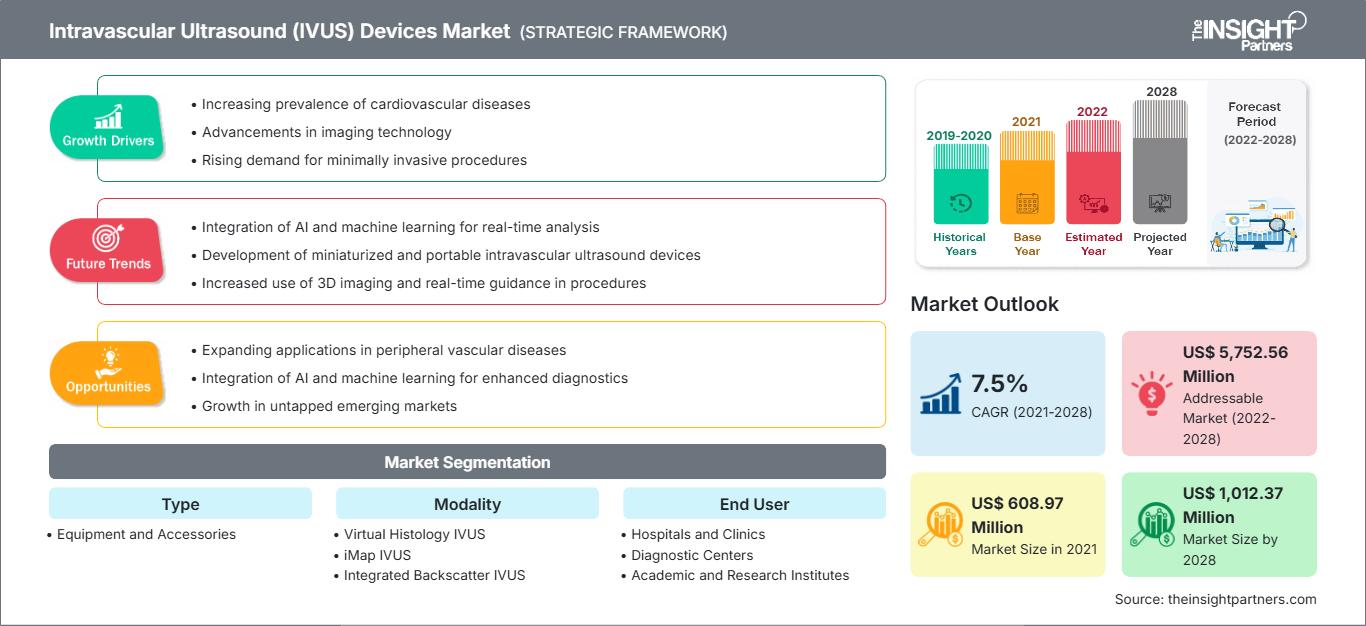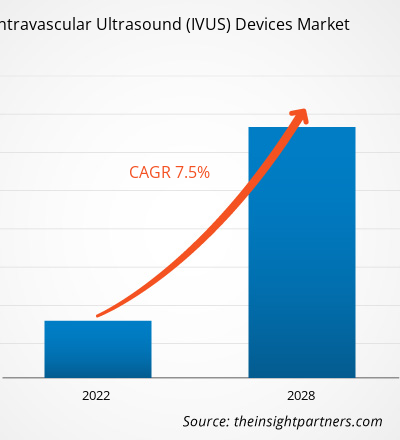[Rapport de recherche] Le marché des dispositifs d'échographie intravasculaire (IVUS) devrait passer de 608,97 millions de dollars US en 2021 à 1 012,37 millions de dollars US en 2028 ; sa croissance devrait atteindre un TCAC de 7,5 % entre 2021 et 2028.
Ce rapport offre des informations et une analyse approfondie du marché des dispositifs d'échographie intravasculaire (IVUS) concernant divers paramètres tels que les tendances et les opportunités du marché, la dynamique du marché et l'analyse du paysage concurrentiel des principaux acteurs du marché en Amérique du Nord, en Europe, en Asie-Pacifique, en Amérique du Sud et centrale, ainsi qu'au Moyen-Orient et en Afrique. Il comprend également une analyse de l'impact de la pandémie de COVID-19 dans ces régions.
Personnalisez ce rapport en fonction de vos besoins
Vous bénéficierez d’une personnalisation sur n’importe quel rapport - gratuitement - y compris des parties de ce rapport, ou une analyse au niveau du pays, un pack de données Excel, ainsi que de profiter d’offres exceptionnelles et de réductions pour les start-ups et les universités
Marché des dispositifs d'échographie intravasculaire (IVUS): Perspectives stratégiques

- Obtenez les principales tendances clés du marché de ce rapport.Cet échantillon GRATUIT comprendra une analyse de données, allant des tendances du marché aux estimations et prévisions.
Vous bénéficierez d’une personnalisation sur n’importe quel rapport - gratuitement - y compris des parties de ce rapport, ou une analyse au niveau du pays, un pack de données Excel, ainsi que de profiter d’offres exceptionnelles et de réductions pour les start-ups et les universités
Marché des dispositifs d'échographie intravasculaire (IVUS): Perspectives stratégiques

- Obtenez les principales tendances clés du marché de ce rapport.Cet échantillon GRATUIT comprendra une analyse de données, allant des tendances du marché aux estimations et prévisions.
Aperçu du marché
Augmentation des maladies cardiovasculaires
Les maladies cardiovasculaires restent la principale cause de morbidité et de mortalité dans le monde. Une mauvaise alimentation est le facteur de style de vie le plus important qui conduit aux maladies cardiovasculaires. Selon l'OMS, les maladies cardiovasculaires sont l'une des causes de décès, responsables de près de 17,9 millions de décès dans le monde en 2019.
Parmi les principaux facteurs de risque de maladies cardiovasculaires figurent les antécédents familiaux, l'origine ethnique, l'âge et d'autres facteurs de risque : tabagisme, hypertension, obésité, taux de cholestérol élevé, sédentarité, diabète, mauvaise alimentation et consommation d'alcool. La majorité des maladies cardiovasculaires peuvent être évitées grâce à une surveillance et un diagnostic préalables à l'aide d'appareils d'échographie intravasculaire. Par conséquent, le nombre croissant de maladies cardiovasculaires stimule la demande d'échographies intravasculaires.
En raison de la pandémie de COVID-19, la demande d'échographies intravasculaires (IVUS) a augmenté. Le marché des échographies intravasculaires (IVUS) en Asie-Pacifique devrait connaître une croissance rapide dans un avenir proche. Cette expansion est principalement due à la disponibilité de techniciens formés et qualifiés et à l'adoption croissante d'équipements de diagnostic de pointe.
Informations basées sur les modalités
Selon la modalité, le marché des échographies intravasculaires (IVUS) est segmenté en IVUS à histologie virtuelle, IVUS iMap et IVUS à rétrodiffusion intégrée. En 2021, le segment IVUS à histologie virtuelle détenait une part de marché plus importante. Cependant, le segment IVUS iMap devrait enregistrer un TCAC plus élevé de 8,0 % au cours de la période de prévision.
Marché des échographies intravasculairesMarché des dispositifs d'échographie intravasculaire (IVUS)
Les tendances régionales et les facteurs influençant le marché des dispositifs d'échographie intravasculaire (IVUS) tout au long de la période de prévision ont été analysés en détail par les analystes de The Insight Partners. Cette section aborde également les segments de marché et la répartition géographique du marché des dispositifs d'échographie intravasculaire (IVUS) en Amérique du Nord, en Europe, en Asie-Pacifique, au Moyen-Orient et en Afrique, ainsi qu'en Amérique du Sud et en Amérique centrale.Portée du rapport sur le marché des dispositifs d'échographie intravasculaire (IVUS)
Attribut de rapport
Détails
Taille du marché en 2021
US$ 608.97 Million
Taille du marché par 2028
US$ 1,012.37 Million
TCAC mondial (2021 - 2028)
7.5%
Données historiques
2019-2020
Période de prévision
2022-2028
Segments couverts
By Type - équipement et accessoires
By Modalité- IVUS d'histologie virtuelle
- IVUS iMap
- IVUS à rétrodiffusion intégrée
By Utilisateur final- hôpitaux et cliniques
- centres de diagnostic
- instituts universitaires et de recherche
Régions et pays couverts
Amérique du Nord- États-Unis
- Canada
- Mexique
Europe- Royaume-Uni
- Allemagne
- France
- Russie
- Italie
- reste de l'Europe
Asie-Pacifique- Chine
- Inde
- Japon
- Australie
- reste de l'Asie-Pacifique
Amérique du Sud et centrale- Brésil
- Argentine
- reste de l'Amérique du Sud et centrale
Moyen-Orient et Afrique- Afrique du Sud
- Arabie saoudite
- Émirats arabes unis
- reste du Moyen-Orient et de l'Afrique
Leaders du marché et profils d'entreprises clés - Koninklijke Philips N.V.
- GE Healthcare
- Siemens AG
- Boston Scientific Corporation
- Infraredx, Inc.
- Terumo Corporation
- Axle International
- Conavi Medical Inc.
- Canon Medical Systems
Densité des acteurs du marché des dispositifs d'échographie intravasculaire (IVUS) : comprendre son impact sur la dynamique commerciale
Le marché des dispositifs d'échographie intravasculaire (IVUS) connaît une croissance rapide, porté par une demande croissante des utilisateurs finaux, due à des facteurs tels que l'évolution des préférences des consommateurs, les avancées technologiques et une meilleure connaissance des avantages du produit. Face à cette demande croissante, les entreprises élargissent leur offre, innovent pour répondre aux besoins des consommateurs et capitalisent sur les nouvelles tendances, ce qui alimente la croissance du marché.
- Obtenez le Marché des dispositifs d'échographie intravasculaire (IVUS) Aperçu des principaux acteurs clés
Marché des dispositifs d'échographie intravasculaire (IVUS)
Les tendances régionales et les facteurs influençant le marché des dispositifs d'échographie intravasculaire (IVUS) tout au long de la période de prévision ont été analysés en détail par les analystes de The Insight Partners. Cette section aborde également les segments de marché et la répartition géographique du marché des dispositifs d'échographie intravasculaire (IVUS) en Amérique du Nord, en Europe, en Asie-Pacifique, au Moyen-Orient et en Afrique, ainsi qu'en Amérique du Sud et en Amérique centrale.Portée du rapport sur le marché des dispositifs d'échographie intravasculaire (IVUS)| Attribut de rapport | Détails |
|---|---|
| Taille du marché en 2021 | US$ 608.97 Million |
| Taille du marché par 2028 | US$ 1,012.37 Million |
| TCAC mondial (2021 - 2028) | 7.5% |
| Données historiques | 2019-2020 |
| Période de prévision | 2022-2028 |
| Segments couverts |
By Type
|
| Régions et pays couverts | Amérique du Nord
|
| Leaders du marché et profils d'entreprises clés |
|

- Obtenez le Marché des dispositifs d'échographie intravasculaire (IVUS) Aperçu des principaux acteurs clés
Informations basées sur le type
En fonction du type, le marché des dispositifs d'échographie intravasculaire (IVUS) est segmenté en équipements et accessoires. En 2021, le segment des accessoires détenait une part de marché plus importante, et ce même segment devrait enregistrer un TCAC plus élevé de 7,7 % sur le marché au cours de la période de prévision.
Informations basées sur l'utilisateur final
En fonction de l'utilisateur final, le marché des dispositifs d'échographie intravasculaire (IVUS) est segmenté en hôpitaux et cliniques, centres de diagnostic et instituts universitaires et de recherche. En 2021, le segment des hôpitaux et cliniques détenait une part de marché plus importante. Toutefois, le segment des centres de diagnostic devrait enregistrer un TCAC plus élevé de 7,9 % au cours de la période de prévision.
Les entreprises adoptent généralement des stratégies inorganiques telles que les fusions et acquisitions pour répondre à l'évolution des demandes des clients et maintenir leurs noms de marque dans le monde entier. Les acteurs du marché des dispositifs d'échographie intravasculaire (IVUS) adoptent également des stratégies organiques, telles que le lancement et l'expansion de produits, pour étendre leur présence et leur portefeuille de produits à l'échelle mondiale et répondre à la demande croissante.
Par type
- Équipement
- Cathéters
- Fils-guides
- Autres
- Accessoires
Par modalité
- IVUS d'histologie virtuelle
- IVUS iMap
- IVUS à rétrodiffusion intégrée
Par utilisateur final
- Hôpitaux et cliniques
- Instituts universitaires et de recherche
- Centres de diagnostic
Par Géographie
- Amérique du Nord
- États-Unis
- Canada
- Mexique
- Europe
- Royaume-Uni
- Allemagne
- France
- Italie
- Espagne
- Reste de l'Europe
- Asie Pacifique
- Chine
- Japon
- Inde
- Australie
- Corée du Sud
- Reste de l'Asie-Pacifique
- Moyen-Orient etamp; Afrique
- EAU
- Arabie Saoudite
- Afrique
- Reste du Moyen-Orient et amp; Afrique
- Amérique du Sud et centrale
- Brésil
- Argentine
- Reste de l'Amérique du Sud et centrale
Profils d'entreprise
- Koninklijke Philips NV
- GE Healthcare
- Siemens AG
- Boston Scientific Corporation
- Infraredx, Inc.
- Terumo Corporation
- Axle International
- Conavi Medical Inc.
- Canon Medical Systems
- Abbott
- ACIST Medical System
- Analyse historique (2 ans), année de base, prévision (7 ans) avec TCAC
- Analyse PEST et SWOT
- Taille du marché Valeur / Volume - Mondial, Régional, Pays
- Industrie et paysage concurrentiel
- Ensemble de données Excel
Rapports récents
Témoignages
Raison d'acheter
- Prise de décision éclairée
- Compréhension de la dynamique du marché
- Analyse concurrentielle
- Connaissances clients
- Prévisions de marché
- Atténuation des risques
- Planification stratégique
- Justification des investissements
- Identification des marchés émergents
- Amélioration des stratégies marketing
- Amélioration de l'efficacité opérationnelle
- Alignement sur les tendances réglementaires




















 Obtenez un échantillon gratuit pour - Marché des dispositifs d'échographie intravasculaire (IVUS)
Obtenez un échantillon gratuit pour - Marché des dispositifs d'échographie intravasculaire (IVUS)